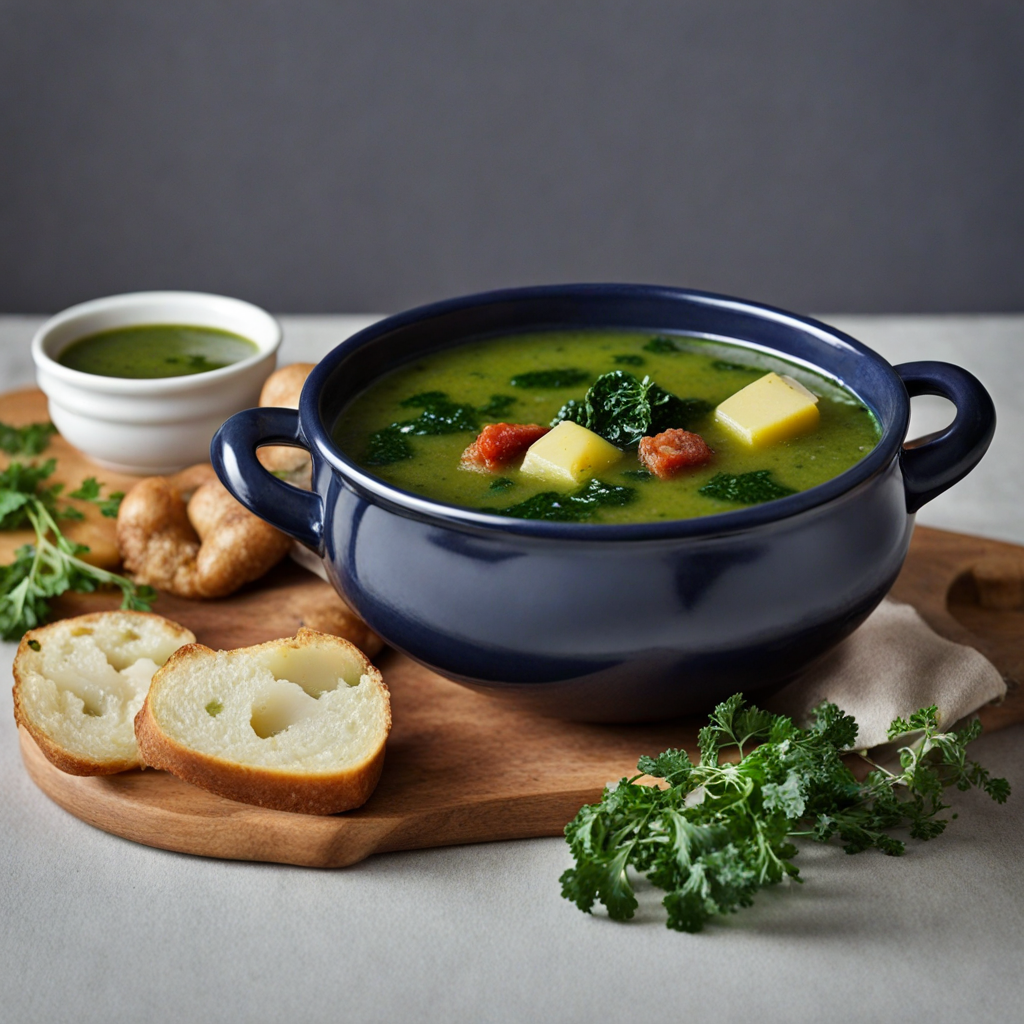Caldo Verde
Caldo Verde, translating to "green broth," is a traditional Portuguese soup that embodies the rustic comfort and simplicity of Portuguese cuisine. This dish has its roots in the northern regions of Portugal, particularly in Minho, where it has been made for centuries. While its exact origins remain somewhat obscure, Caldo Verde is often associated with the rural communities of Portugal, where it was a staple for laborers and farmers. The soup's popularity has transcended regional boundaries, making it a beloved dish nationwide, often served at family gatherings and festive occasions. The flavor profile of Caldo Verde is a delightful balance of earthy and fresh notes, primarily attributed to its key ingredients. The soup features a base of potatoes, which provide a creamy texture, while the star ingredient, kale (traditionally, it is made with a specific Portuguese variety called "couve galega"), adds a vibrant green color and a slightly bitter, yet refreshing taste. The addition of olive oil enhances the overall richness, while a hint of garlic and sometimes onions offers depth and warmth. Depending on regional variations and personal preferences, some versions may include chorizo or other types of sausage, which contribute a smoky and savory element to the broth. Preparation of Caldo Verde is relatively straightforward, making it an accessible dish for home cooks. It begins with boiling diced potatoes in water or vegetable broth until tender. Once cooked, the potatoes are mashed or blended to create a creamy base. Next, finely sliced kale is added to the pot, along
How It Became This Dish
Caldo Verde: A Culinary Journey Through Portuguese History Caldo Verde, a vibrant and hearty soup, is more than just a dish in Portugal; it is a symbol of the nation’s cultural identity and culinary heritage. Originating in the northern Minho region, this humble soup has a rich history that reflects the agricultural practices, social customs, and historical events that have shaped Portuguese society. Origins The roots of Caldo Verde can be traced back to the rural communities of northern Portugal, particularly in the province of Minho, around the late 19th century. Its name translates to "green broth," aptly describing its appearance, which is characterized by the deep green color of its primary ingredient: kale, or "couve galega." This leafy green was a staple in the diets of local farmers and laborers, making it a natural choice for a nourishing and economical dish. The soup typically consists of just a few ingredients: finely shredded kale, potatoes, onions, garlic, olive oil, and salt, with the option to include chorizo or other sausages for added flavor. The simplicity of Caldo Verde speaks to the frugality of rural life, where families relied on seasonal produce and ingredients that were readily available. The dish became particularly popular in the colder months, providing warmth and sustenance to those who toiled in the fields. Cultural Significance Caldo Verde is not merely a staple food; it is steeped in cultural significance in Portugal. It is often served during important celebrations and gatherings, such as weddings, festivals, and even at the New Year’s Eve meal. The soup embodies the spirit of community and togetherness, as it is often made in large quantities to be shared among family members and friends. One of the most notable occasions for serving Caldo Verde is the "Santo António" festival, celebrated in Lisbon in June. This festival honors Saint Anthony, known as the protector of lovers and the finder of lost items. During this time, Caldo Verde is enjoyed alongside grilled sardines, a traditional pairing that highlights the culinary diversity of Portuguese culture. The soup's presence at such significant events underscores its status as a comfort food that brings people together, reinforcing social bonds and a sense of belonging. Development Over Time As Portugal evolved through the 20th century, so did Caldo Verde. The soup transitioned from a rural staple to a dish enjoyed by all social classes. The industrialization of agriculture and urban migration led to changes in dietary habits and food preparation methods. While traditional recipes remained popular, modern variations began to emerge. In urban areas, Caldo Verde was often served in restaurants and taverns, becoming a beloved dish among city dwellers. Chefs began to experiment with the recipe, introducing new ingredients and flavors while still honoring the traditional elements. For instance, some versions incorporated different types of greens or added beans for extra protein, reflecting the culinary creativity that characterizes Portuguese cuisine. The globalization of food culture also played a role in the evolution of Caldo Verde. As Portuguese immigrants settled in various parts of the world, particularly in the United States, Canada, and Brazil, they brought their culinary traditions with them. Caldo Verde found a new audience, and variations of the soup began to emerge, incorporating local ingredients and flavors. This cross-cultural exchange enriched the dish, allowing it to adapt and thrive in diverse culinary landscapes. Modern-Day Caldo Verde Today, Caldo Verde remains a beloved dish in Portugal and beyond. It is often featured on menus in Portuguese restaurants worldwide, celebrated for its comforting qualities and nutritional value. The soup's reputation as a healthful meal is well-deserved; kale is packed with vitamins, while the olive oil and potatoes provide essential fats and carbohydrates. In contemporary Portuguese cuisine, there is a renewed interest in traditional dishes like Caldo Verde, as chefs and home cooks alike seek to preserve culinary heritage while also embracing innovation. The resurgence of the farm-to-table movement has further enhanced the appreciation for locally sourced ingredients, allowing Caldo Verde to shine as a seasonal dish that reflects the bounty of the land. Moreover, Caldo Verde has become an emblem of nationalism, especially among the Portuguese diaspora. It represents a connection to heritage and home, often evoking nostalgic memories of family gatherings and cultural celebrations. The soup's role in Portuguese identity is underscored by its appearance in literature, film, and art, where it is often associated with themes of comfort, nostalgia, and belonging. Conclusion Caldo Verde is more than just a soup; it is a culinary narrative that tells the story of Portugal itself. From its humble origins in the northern countryside to its status as a beloved dish in homes and restaurants around the world, Caldo Verde encapsulates the essence of Portuguese culture. Its simplicity, warmth, and adaptability speak to the resilience of a nation that has weathered countless changes over the centuries. As we savor a bowl of Caldo Verde, we are not just enjoying a meal; we are partaking in a shared history that transcends generations. The soup embodies the spirit of community, tradition, and innovation, making it a timeless dish that will continue to nourish both body and soul for years to come. Whether enjoyed on a cold winter's night or during a festive celebration, Caldo Verde remains a cherished symbol of Portugal's rich culinary heritage, reminding us of the power of food to connect us to our roots and to each other.
You may like
Discover local flavors from Portugal







